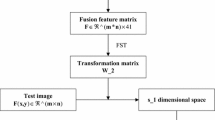Abstract
Feature level fusion is a very well known technique for improving the performance of a face recognition system. This paper presents an approach of fusion of directional spatial discriminant features for face recognition. The key idea of the proposed method is to fuse the facial features lying along the horizontal, vertical and diagonal directions, so that this fused feature vector can contain more discriminant information than the individual facial feature of single direction only. However due to the fusion of features the size of fused feature vector becomes larger, which may increase complexity of the classifier to be used for recognition. To optimize this lower dimensional discriminant features are again extracted from this large fused feature vector. In our experiment we have applied G-2DFLD method on the original images to extract the discriminant features. Then original images are converted into diagonal images and another set of discriminant features, representing the diagonal information, are extracted by using the G-2DFLD method. The original and diagonal feature matrices are then fused to form a large feature matrix. The dimension of this large fused matrix is then further reduced by G-2DFLD method and this resultant matrix is used for classification and recognition by Radial Basis Function-Neural Networks (RBF-NN). Experiments on the AT&T (formally known as ORL database) face database indicate the competitive performance of the proposed method, as compared to some existing subspaces-based methods.
Access this chapter
Tax calculation will be finalised at checkout
Purchases are for personal use only
Preview
Unable to display preview. Download preview PDF.
Similar content being viewed by others
References
Sirovich, L., Kirby, M.: Low-dimensional procedure for the characterization of human faces. Journal of Optical Society of America 4, 519–524 (1987)
Sirovich, L., Kirby, M.: Multi-directional two dimensional PCA with matching score level fusion for face recognition. Neural Comput. & Applic. 23, 169–174 (2013)
Yang, J., Zhang, D., Frangi, A.F., Yang, J.Y.: Two-dimensional PCA: A new approach to appearance-based face representation and recognition. IEEE Trans. Pattern Anal. Mach. Intell. 26, 131–137 (2004)
Belhumeur, P.N., Hespanha, J.P., Kriegman, D.J.: Eigenfaces versus fisherfaces: Recognition using class specific linear projection. IEEE Trans. Pattern Anal. Mach. Intell. 19, 711–720 (1997)
Er, M.J., Wu, S., Lu, J., Toh, H.L.: Face recognition with radial basis function (RBF) neural networks. IEEE Trans. Neural Networks 13, 697–710 (2002)
Xiong, H., Swamy, M.N.S., Ahmad, M.O.: Two-dimensional FLD for face recognition. Pattern Recognition 38, 1121–1124 (2005)
AT&T face database, AT&T Laboratories, Cambridge, U.K., http://www.uk.research.att.com/facedatabase.html
Su, C., Deng, J., Yang, Y., Wang, G.: Expression Recognition Methods Based on Feature Fusion. In: Yao, Y., Sun, R., Poggio, T., Liu, J., Zhong, N., Huang, J. (eds.) BI 2010. LNCS, vol. 6334, pp. 346–356. Springer, Heidelberg (2010)
Noushatha, S., Hemantha Kumara, G., Shivakumara, P.: Diagonal Fisher linear discriminant analysis for efficient face recognition. Neurocomputing 69, 1711–1716 (2006)
Sing, J.K., Roy, D., Basu, D.K., Nasipuri, M.: Generalized Diagonal 2D FLDA for Efficient Face Recognition. In: Proceeding of the CODIS 2012, pp. 101–112 (2012)
Chowdhury, S., Sing, J.K., Basu, D.K., Nasipuri, M.: Face recognition by generalized two-dimensional FLD method and multi-class support vector machines. Applied Soft Computing 11, 4282–4292 (2011)
Author information
Authors and Affiliations
Editor information
Editors and Affiliations
Rights and permissions
Copyright information
© 2014 Springer International Publishing Switzerland
About this paper
Cite this paper
Dey, A., Chowdhury, S., Sing, J.K., Basu, D.K., Nasipuri, M. (2014). An Efficient Face Recognition Method by Fusing Spatial Discriminant Facial Features. In: Gupta, P., Zaroliagis, C. (eds) Applied Algorithms. ICAA 2014. Lecture Notes in Computer Science, vol 8321. Springer, Cham. https://doi.org/10.1007/978-3-319-04126-1_24
Download citation
DOI: https://doi.org/10.1007/978-3-319-04126-1_24
Publisher Name: Springer, Cham
Print ISBN: 978-3-319-04125-4
Online ISBN: 978-3-319-04126-1
eBook Packages: Computer ScienceComputer Science (R0)




